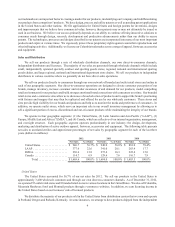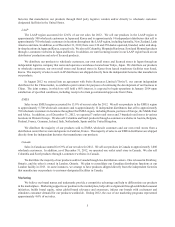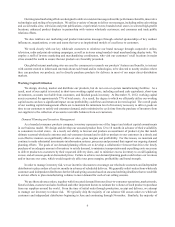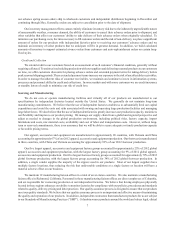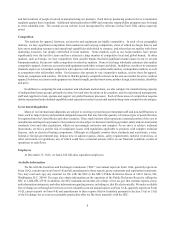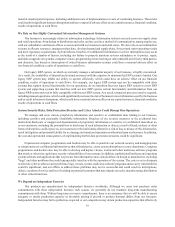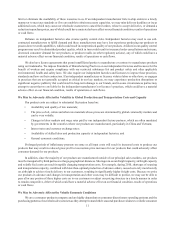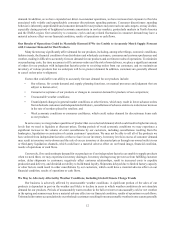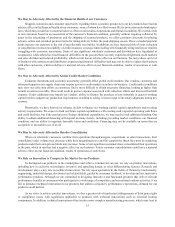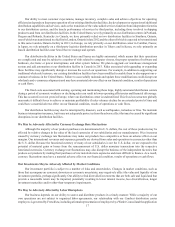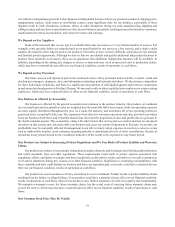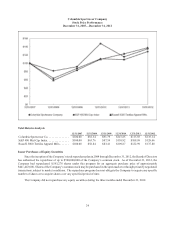Columbia Sportswear 2012 Annual Report Download - page 18
Download and view the complete annual report
Please find page 18 of the 2012 Columbia Sportswear annual report below. You can navigate through the pages in the report by either clicking on the pages listed below, or by using the keyword search tool below to find specific information within the annual report.14
brand in key European markets, where we have significant infrastructure investments. If any of these or other factors make
the conduct of business in a particular country undesirable or impractical, our business may be materially and adversely
affected. As we expand our operations in geographic scope and product categories, we anticipate intellectual property
disputes will increase, making it more expensive and challenging to establish and protect our intellectual property rights
and to defend against claims of infringement by others.
In addition, many of our imported products are subject to duties, tariffs or other import limitations that affect the cost
and quantity of various types of goods imported into the United States and other markets. Any country in which our products
are produced or sold may eliminate, adjust or impose new import limitations, duties, anti-dumping penalties or other charges
or restrictions, any of which could have a material adverse effect on our financial condition, results of operations or cash
flows.
We May Have Additional Tax Liabilities
As a global company, we determine our income tax liability in various competing tax jurisdictions based on an analysis
and interpretation of local tax laws and regulations. This analysis requires a significant amount of judgment and estimation
and is often based on various assumptions about the future actions of the local tax authorities. These determinations are the
subject of periodic domestic and foreign tax audits. Although we accrue for uncertain tax positions, our accrual may be
insufficient to satisfy unfavorable findings. Unfavorable audit findings and tax rulings may result in payment of taxes, fines
and penalties for prior periods and higher tax rates in future periods, which may have a material adverse effect on our
financial condition, results of operations or cash flows. Changes in tax law or our interpretation of tax laws and the resolution
of current and future tax audits could significantly affect the amounts provided for income taxes in our consolidated financial
statements.
We earn a significant amount of our operating income from outside the U.S., and any repatriation of funds currently
held in foreign jurisdictions may result in higher effective tax rates for Columbia. If we encounter a significant need for
liquidity domestically or at a particular location that we cannot fulfill through borrowings, equity offerings or other internal
or external sources, we may experience unfavorable tax and earnings consequences as a result of cash transfers. These
adverse consequences would occur, for example, if the transfer of cash into the United States is taxed and no offsetting
foreign tax credit is available to offset the U.S. tax liability, resulting in lower earnings. Furthermore, foreign exchange
ceilings imposed by local governments and the sometimes lengthy approval processes that foreign governments require for
international cash transfers may delay or otherwise limit our internal cash transfers from time to time.
We Operate in Very Competitive Markets
The markets for apparel, footwear, accessories and equipment are highly competitive, as are the markets for our
licensed products. In each of our geographic markets, we face significant competition from global and regional branded
apparel, footwear, accessories and equipment companies.
Retailers who are our customers often pose our most significant competitive threat by designing and marketing apparel,
footwear, equipment and accessories under their own private labels. For example, in the United States, several of our largest
customers have developed significant private label brands during the past decade that compete directly with our products.
These retailers have assumed an increasing degree of inventory risk in their private label products and, as a result, may first
cancel advance orders with us in order to manage their own inventory levels downward during periods of unseasonable
weather or weak economic cycles.
We also compete with other companies for the production capacity of independent factories that manufacture our
products and for import capacity. Many of our competitors are significantly larger than we are and have substantially greater
financial, distribution, marketing and other resources, more stable manufacturing resources and greater brand strength than
we have. In addition, when our competitors combine operations through mergers, acquisitions or other transactions, their
competitive strength may increase.
Increased competition may result in reduced access to production capacity, reductions in display areas in retail
locations, reductions in sales, or reductions in our profit margins, any of which may have a material adverse effect on our
financial condition, results of operations or cash flows.


